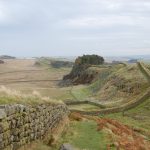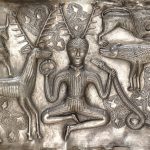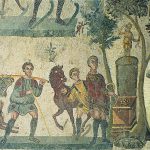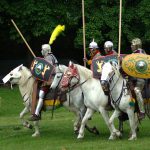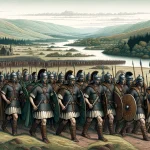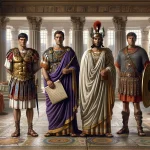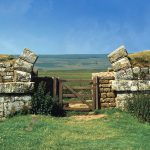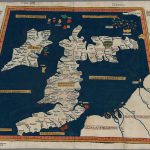Caerleon (Isca Silurum) Roman Fortress
Amphitheatre, Legionary Fort and Vicus
Situated on the south-western edge of the modern town of Caerleon in Gwent, is the Isca Silurum (or Isca Augusta) legionary fortress which had a standard, playing-card outline measuring 1,600 by 1,350 feet (c.490×410 metres) and encloses an area within the defences of some 50 acres (21ha), easily large enough to house a fully-manned legion of between five and six thousand men. The defences of the fortress are aligned towards the north-west, which implies that the most significant threat was expected to come from that quarter.
The original Flavian timber fortress was built sometime between 70AD to 80, which may place the foundation during the campaigns of governor Sextus Julius Frontinus in 74-75. It was certainly built by the men of Legio II Augusta, who continued to garrison the fortress until the mid-fourth century. An inscription of Trajan gives us a fairly precise dating for the replacement of the fortress walls to 99/100AD, when the original earth and timber ramparts of the fortress were strengthened by the addition of a stone revetment at the front. Defences of this “composite” rampart consisted of a stone wall 5 to 5½ feet thick, backed by a clay bank and fronted by a single ditch.
RIB 328 - Inscription
Dedicated on September 23rd in the consulship of Pupienius Maximus, for the second time, and of Urbanus.
VIIII A D Ḳ[...]
OC[...]ES
[...]V[...]NIO
MAXIMO II
ET VRBANO
COS
For the date, 23 September, see RIB 327.
Between 140AD and 200 occupation evidence is slight, and it has been suggested that most of Legio II Augusta was away in Scotland during this period. The fortress was damaged c.196/7, but by the turn of the third century the legion was evidently back in residence, an inscription records repairs made c.197-211 and another records that the barracks were rebuilt in stone during 259. The coin sequence in the fortress stops in 296, coincident with the period when the legionary fortress at York was rebuilt, and it seems that Caerleon was abandoned at this time, the Legion perhaps moving for a short while to garrison the Coastal Fortress at Cardiff – which had just been rebuilt – before being relocated to Rutupiae on the coast of Cantium.
During excavations at Caerleon over the years a number of animal bones have been uncovered, including those of domesticated Ox, Sheep, Goat, and Pig, also game animals such as Red Deer, Roe Deer, Boar and Hare, and even those of Fox and Wolf; the latter animals very likely being hunted and killed for sport and as a means of pest control. In addition, the soldiers’ diet was supplemented by seawater molluscs including Oyster, Mussel, Limpet and Cockle.
RIB 395 - Boundary stone of Statorius Maximus
From the first cohort, the century of Statorius Maximus (built) 33½ paces.
𐆛 STATORI
M[...]XIMI
P X[...]XIII S
The distance of 33½ paces suggests that 100 paces had been divided among three centuries. For the approximation of 3,666½ paces to 3-⅔ Roman miles (c. 5.4 km.) see RIB 2186, 2193, 2194, 2196 on the Antonine Wall. Addenda from RIB+add. (1995): The find-spot is illustrated by Boon, Monm. Ant. 2 (1967), 125-6, who suggests that the earthwork it implies may have divided the prata of the Legion from the territory of the civitas Silurum.
The Builders of the Legionary Fortress
RIB 343 - Centurial stone of Flavius Julinus
From the tenth cohort, the century of Flavius Julinus (built this).
No commentary.
RIB 347 - Centurial stone of Licinius Nerva
The century of Licinius Nerva (built this).
No commentary.
Stamped Tiles from Caerleon
“[Property of] the Second Augustan Legion.”
Classical references to Isca Augusta (Caeleon)
The Roman name of the Caerleon fortress occurs in three separate itinera within the late-second century list of imperial road-routes known as the Antonine Itinerary, serving as a terminus on two of these routes.
- Iter XII: “the route from Muridunum to Viroconium“, Caerleon appears as Iscae the home of Legio Secunda Augusta, some twenty-seven miles from Bomium (nr. Bridgend, Mid Glamorgan) and nine miles from Burrium (Usk, Gwent).
- Iter XIII: “the route from Isca to Calleva, one-hundred and nine thousand paces”; a road journey which again starts off with the nine mile road to Burrium (Usk, Gwent), then via Blestium (Monmouth, Gwent) a further eleven miles further along the north bank of the Severn Estuary.
- Iter XIV: “an alternative route from Isca to Calleva, one-hundred and three thousand paces”, begins with a nine mile road trip to the civitas capital Venta Silurum (Caerwent, Gwent), followed by a fourteen mile journey across the Bristol Channel to Abona (Sea Mills, Avon).
The only other classical geography which mentions the Caerleon fort is the Ravenna Cosmology of the seventh century, where the name Isca Augusta (R&C#52) occurs between the entry for Bannio (Abergavenny, Gwent) and the unidentified station Albinumno.
The modern name for the fortress of the Second Legion Augusta, Caerleon, is an amalgam of the British word *caer/gaer ‘camp, fort’, and the Latin legionis ‘of the legion’. Gildas (x.2) mentions two Christian martyrs, namely Aaron and Julius, who were described as Legionum urbis cives ‘citizens of the Legionary town’ (i.e. Caerleon).
The Epigraphy of Isca Silurum
There are eighty-five inscribed stones recorded in the RIB for Caerleon, including thirty-two tombstones, twenty-three centurial and cohort stones, fourteen altars and votive stones, and nine dateable inscriptions.
The Dateable Inscriptions from Isca Silurum
Legio Secundae Augusta – The Second Augustan Legion
RIB 330 - Commemorative slab
For the Emperor Caesar Nerva Trajan Augustus, conqueror of Germany, son of the deified Nerva, pontifex maximus, with tribunician power, father of his country, consul for the third time, the Second Legion Augusta (erected this).
NERVAE TRAIA[...] ▸ [...] ▸
GER ▸ PONTIF ▸ MAXIMO ▸ [... ] ▸
POTEST ▸ P ▸ P
COS ▸
Dr. F.J. North (Department of Geology, National Museum of Wales, Cardiff) to R.P.W., 15 June 1959, reported that this is a statuary marble, which is more likely to have come from Tuscany than anywhere else.5. cos ii, altered to cos iii. Apparently it was drafted in A.D. 99, while Trajan was consul iterum, and was brought up to date in A.D. 100, when he became consul tertium. No numeral was placed after trib. potest., though from 10 December 99 Trajan was t. p. iiii.
RIB 326 - Inscription
… for the welfare of our August (Emperors) Severus and Antoninus, and of Geta Caesar, Publius Saliienus Thalamus, son of Publius, of the Maeician voting-tribe, from Hadria, prefect of the Second Legion Augusta with Ampeianus and Lucilianus [his sons … set this up].
PRO SALVTE
AVGG NN
SEVERI ET ANTONI
NI ⟦ET GETAE CAES⟧ P SALIIENVS P F MAEI
CIA THALAMVS HADRI
PRAEF LEG II AVG
CV AMPEIANO ET LVCILIA[...]
For Sallienius, see also RIB 324.Wood, The Manor and Mansion of Moyne’s Court, Monmouthshire (1914) dates the discovery of this inscription to 1606 or 1607, and points out that Bishop Godwin must have placed his Caerleon inscriptions (RIB 316, 326, 331, 335, 352) at the episcopal palace at Mathern until at least 1608 when he bought Moyne’s Court, Mathern, for himself. But Godwin mentions the Haterianus inscription (RIB 335) in a letter to Camden, 14 July 1603 (Camden, W., B.M. MS. Cotton Julius F. VI f. 297 [282]).
RIB 331 - Commemorative slab
For the Emperor Caesar Marcus Aurelius Antoninus Pius Felix Augustus, son of Lucius Septimius Severus Augustus, the Second Legion Augusta (built this).
M AV[...]
ANTO[...]
P F AVG [...]
ṢẸVERI [...]
FILIO
[...]G II [...]
Imp. Caes. Marco Aurelio Antonino: Caracalla, A.D. 211-17.
RIB 327 - Dedication to the Divinities of the Emperors and the Genius of the Second Legion
To the Divinities of the Emperors and the Genius of the Second Legion, in honour of the Eagle, the senior centurion gave this gift dedicated on September 23rd in the consulship of Peregrinus and Aemilianus, under the charge of Ursus, actarius of the same legion.
For actarius see Glossary.The consulship of Peregrinus and Aemilianus was A.D. 244 (as Mommsen saw). 23 September, the birthday of Augustus, would be observed by a legion styled Augusta as its own birthday.
RIB 334 - Commemorative tablet
The Emperors Valerian and Gallienus, Augusti, and Valerian, most noble Caesar, restored from ground-level barrack-blocks for the Seventh Cohort, through the agency of Desticius Juba, of senatorial rank and emperors’ propraetorian legate, and of Vitulasius Laetinianus, legate of the Second Legion Augusta, under the charge of Domitius Potentinus, prefect of the said legion.
AVG ET VALERIANVS NOBILISSIMVS
CAES COHORTI VII CENTVRIAS A SO
LO RESTITVERVNT PER DESTICIVM IVBAM
V C LEGATVM AVGG PR PR ET
VITVLASIVM LAETINIANVM LEG LEG
II AVG CVRANTE DOMIT POTENTINO
PRAEF LEG EIVSDEM
Some of the letters of impp (l. 1) and avgg (l. 2) have been damaged with a pick.The dating is about a.d. 255-60. If Valerianus nob. Caes. refers to the elder son of Gallienus, the inscription would fall between 255 and 258 (PW xiii, i col. 244); if to the younger son, then between 258-60 (ibid. col. 238).Huebner suggests that Juba is probably to be identified with T. Desticius Iuba, c.u., praetorius, patronus coloniae Concordiae (CIL v 1875). The praefectus legionis was originally styled praefectus castrorum legionis.
There are at least seventeen stones which attest the presence of Legio II Augusta at Caerleon, there is a dedicatory inscription to Mithras (RIB 322), an altar to Regina (RIB 324), five building inscriptions (RIB 326/7, 330/1, 334; vide supra), dating from the reign of Trajan (99/100AD) to that of Valerian and Gallienus (255-260AD), there are also nine tombstones of soldiers (RIB 357, 359-361, 363 & 365-368; vide infra) and another possible funerary inscription (RIB 385) attributable to men of the Second Legion including a damaged testament of a signifer of the legion (RIB 367; not shown).
RIB 365 - Funerary inscription for Gaius Valerius Victor
To the spirits of the departed Gaius Valerius Victor, son of Gaius, of the Galerian voting-tribe, from Lugdunum, standard-bearer of the Second Legion Augusta, of 17 years’ service, aged 45 set up under the charge of Annius Perpetuus, his heir.
G VALERIVS G F
GALERIA VICTOR
LVGDVNI SIG LEG II AVG
STIP XVII ANNOR XLV CV
RA AGENT ANNIO PERPETVO H
Lugdunum: Lyons.
RIB 385 - Dedication by a primus pilus of the Second Legion Augusta
… of the Sergian voting-tribe, from …, senior centurion of the Second Legion Augusta, from his own resources without money transferred from the public chest.
SERG[ 7]
DOM[ 5]
P ▸ P ▸ LEG [...]
D ❦ [...]
SINE ▸ TRA[...]
EX ▸ ARC[ ...]
Presumably formed part of an area, structure, or the like given to a burial guild.For an ark(arius) at Chichester see Brit. x (1979), 339 No. 1.
The Gods of Roman Caerleon
Iupitter
Restoration of a Temple to Iupitter Optimus Maximus During the Reign of Marcus Aurelius and Commodus
“For Jupiter Best and Greatest and the Guardian Spirit of the Emperors Antonine and Commodus the Augusti,¹ this temple was restored from ground-level.”
(Britannia 1970.1; dated: 177-180AD)
- Imperator Caesar Marcus Aurelius Antoninus Augustus and his warped son Imperator Caesar Lucius Aurelius Commodus Augustus. Marcus Aurelius (‘the philosopher’) had been adopted at the age of sixteen by Antoninus Pius in February 138 along with the like-named seven year-old son of his first chosen successor Lucius Ceionius Commodus. Marcus and Lucius Verus (as he was then known), became joint emperors upon Pius’ death of natural causes in March 161, and ruled together without rancour until Verus’ death after suffering a stroke in February 169. Marcus had elevated his own five year-old son Commodus to the rank of Caesar in 166, and he was made joint Augustus in 177. After becoming sole ruler on his father’s death of natural causes in March 180, he was strangled at Rome in December 192 after spending a depraved twelve years as head of the Roman State.
RIB 320 - Dedication to Jupiter Optimus Maximus of Doliche
To Jupiter Best and Greatest, of Doliche … Fronto Aemilianus … Calpurnius … Rufilianus, legate of the emperors, (set this up) at the bidding (of the god).
FRONṬO AEMILIANVS [...]
CALPVRNIVS [...]
RVFILIANVS [...]EG[...]
AVGVSTORVM
MONITV
Aemilianus was probably commandant of the Second Legion (Birley, Antiq. J 16 (1936) 115), and not governor of Britain. The use in full of legatus Augustorum suggests a date during the first joint reign, A.D. 161-9.
RIB 319 - Altar dedicated to Jupiter Optimus Maximus
To Jupiter Best and Greatest.
No commentary.
Fortuna
RIB 318 - Dedication to Fortune and Bonus Eventus
To Fortune and Bonus Eventus, Cornelius Castus and Julia Belismicus, husband and wife, set this up ..
NTO CORNELI CASTVS ET IVL
BELISMICVS CONIVGES
PO[...]
For Bonus Eventus et Fortuna see RIB 642.Belismicus seems to be a Celtic feminine; cf. Vallaunius (RIB 369).
RIB 317 - Dedication to Fortune
To the goddess Fortune Julius [Ba]ssus, camp-prefect, (set this up).
[...]ORTV
NAE
[...]VLIVS
[...]SSVS
PRAEF
CASTROR
The full title praefectus castrorum marks this as earlier than the third century.
Other Altarstones and Votive Objects to the Gods
RIB 325 - Boundary-stone
Boundary-stone.
No commentary.
RIB 316 - Building dedication
Titus Flavius Postumius Varus, senator and legate (of the legion), restored the temple of Diana.
[...]ARVS ▸ V ▸ C ▸ LEG
TEÍ¡MÍ¡PL ▸ DIANAE
RESTITVIT ▸
v(ir) c(larissimus): of senatorial rank. leg(atus) is commandant of the legion (Birley, Antiq. J 16 (1936) 115) and not the provincial governor (PIR¹ ii 72; Atkinson, JRS 12 (1922) 62, 73). Varus is probably to be identified with Postumius Varus, praefectus urbi in A.D. 271. The Caerleon inscription falls probably before a.d. 258, when the emperor Postumus founded his independent Gallic empire (Birley loc. cit.). A presumed descendant with the same four names received a Christian epitaph in Rome (CIL vi 31985). Addenda from RIB+add. (1995): For the tombstone and metrical epitaph of T. Flavius Postumius Varus, see ILS 2940 (Rome).
RIB 321 - Dedication to Mercury
To the god Mercury Cur(…) gave this as a gift, Severus put it up.
CVR D D SEVER P
No commentary.
RIB 322 - Dedication to Mithras
To the Invincible Mithras, the well-deserving, […]s Justus, […] of the Second Legion Augusta, set this up.
[...]HRAE
[...]S IVSTVS
[...]G II AVG
[...] M F
No commentary.
RIB 323 - Curse
Lady Nemesis, I give thee a cloak and a pair of boots let him who wore them not redeem them except with his life and blood.
MESIS DO TI
BI PALLEVM
ET GALLICVLAS
QVI TVLIT NON
REDIMAT NI
V[...]TA SANGVINE
SVẠ
No commentary. Addenda from RIB+add. (1995): The tablet curses a thief who has stolen a cloak and a pair of boots. For galliculas see now Tab. Vindol. II 197.
RIB 324 - Altar dedicated to Salus the Queen
To Salus the Queen Publius Sallienius Thalamus, son of Publius, of the Maecian voting-tribe, from Hadria, prefect of the Second Legion Augusta, with his sons Ampeianus and Lucilianus gave this gift.
GINAE P SAL
LIENIVS P F
MAECIA THA[...]
MVS HAD[...]
PREF LEG II A[...]
CVM FILIS SVIS
AMPEIANO ET LV
CILIANO D D
For the same man see RIB 326. Hadria, in Picenum, on the Adriatic coast of Italy.
Altar to the Numinibus Augustorum
“To the Divine Spirits of the Emperors, Commitus willingly and deservedly fulfills his vow.”
(Britannia 1977.16; altarstone)
Altarstones Dedicated to Unknown Gods
RIB 332 - Fragmentary dedication
… willingly and deservedly fulfilled his vow.
[...]
V S L M
The altar is genuine, but R.G.C. regards the text as a forgery (see Cat. loc. cit.). R.P.W. thinks that the last line is part of an original text over which three lines of text purporting to refer to the emperor Commodus have been cut in Roman style in inferior lettering. See RIB 2353*.
RIB 329 - Fragmentary dedication
… of the same set this up in accordance with his vow.
[...]SDEM EX
VOTO PO
VSVIT
No commentary.
RIB 333 - Inscription
The Emperor-Caesars Lucius Septimius Severus Pius Pertinax Augustus and Marcus Aurelius Antoninus Augustus and Publius Septimius Geta, most noble Caesar … [restored the building] ruined by age.
[... ]VG ⟦ET⟧ ⟦P⟧ SEPTIMIVS ⟦GETA⟧ [...]
[... ]ORRVPTVM ❦ [...]
Perhaps from the Headquarters Building of the fortress. The building meant need not have been the entire Headquarters Building, but some part of it, as for example the tabularium.A.D. 198-209. In l. 2 the erasure of et may be due to a confusion with the name geta, which would occur later in the same line and would be intentionally deleted in A.D. 212.
The Military Amphitheatre
A large amphitheatre built c.80AD could hold six thousand people within its wooden superstructure, and was probably used for parades, displays and exercises by the garrison of the fortress as well as for the usual gladiatorial entertainments. This (Period I) building was destroyed by fire in the early-second century, and the second (Period II) building erected c.138AD was destroyed around sixty years later c.196/7. It was rebuilt for the third and last time during the campaigns of Severus and Caracalla in Britain c.197-211. The Period III building finally fell into disuse around the middle of the fourth century at the same time that the Caerleon fortress was evacuated. The latest coin from the site is that of Valens (364-378AD).
Beside the River Usk was a massive quay which could accomodate ships with a draught of up to five feet (1.6 metres) at high tide. Nearby, the large baths complex with a swimming pool was still in use in c.345AD when final rebuilding took place. Repairs to the local road network outside the fortress was last carried out c.301-306.
Building Inscription Recording the Govenorship of Desticius Juba
“For the emperors Valerianus Augustus, Gallienus Augustus and the most noble Valerianus Caesar,¹ the centuries of the Seventh Cohort, restored [this building] from the foundations, under the most honourable Desticius Juba,² pro-praetorian legate of the emperors, and the legate Vitulasius Laetinianus of the Second Augustan Legion, under the direction of Domitius Potentinus, prefect of the forementioned legion”
(RIB 334; CIL VII.107; ILS 537; dated: 256-258AD)
- Imperator Caesar Publius Licinius Valerianus Pius Felix Invictus Augustus (Valerian) and his elder son Imperator Caesar Publius Licinius Egnatius Gallienus Pius Felix Invictus Augustus (Gallienus) were joint emperors from October 253AD until Valerian’s death in June 260, whereupon Galleinus became sole emperor. Valerians younger son, also named Publius Licinius Valerianus, was given the rank of Caesar in 256 and died early in 258; the stone must date somewhere in this latter period.
- Governor Desticius Juba administered Britain between 256AD and 258.
A Selection of Tombstones from Roman Caerleon
RIB 371 - Funerary inscription for Caesoria Coro[ti]ca
To the spirits of the departed Caesoria Coro[ti]ca lived 48 years Ren[atu]s, her husband, and Munatius and Lestinus and Leontius, her sons, set this up.
CAESORIA CORO[...]
CA V A XLVIII [...]EN[...]
S CONIVX [...]S ET
MVNAT[...] LEST
INVS E[ ]EONTI
VS FECER[...]NT
FILI EIVS
5. For Munatius as a cognomen see ILS 9169. It seems unlikely that one son would have nomen and cognomen, Munatius Celestinus, while his father and brother had only one name each, so it seems better to restore l. 5 as mvnat[ivs et] lestinvs. Professor Ifor Williams (cited by Nash-Williams) accepts Lestinus as a name of probably Celtic derivation. Addenda from Britannia 44 (2013): In l. 2, Wright restores Coro[c]ca, after the unique name Corocus (CIL ii 5611), but the name Corotica is now attested by RIB 3053; in the masculine form Coroticus it is borne by the fifth-century king to whom St Patrick addressed his Epistle. This restoration has also been suggested by A. Kokoschke, Die Personennamen im römischen Britannien (2011), 318, s.v. Coroccus
RIB 377 - Funerary inscription for Julia Iberna
To the spirits of the departed Julia Iberna lived 16 years, 11 months Flavia Flavina, her mother, had this set up.
[... ]A IBERNA VIXS[...]
[...] ANNOS XVI MESSE XI F
C FLA FLAVINA MATER
No commentary.
References for Isca Silvrvmcastra Legionis
- The Romans in Britain An anthology of Inscriptions by A.R. Burn (Oxford 1932);
- The Roman Inscriptions of Britain by R.G. Collingwood and R.P. Wright (Oxford 1965);
- Britannia i (1970) pp.272/3 & p.305 no.1; The Roman Military Diet by R.W. Davies, in Britannia ii (1971) pp.122-142;
- Britannia viii (1977) pp.429-30 no.16; De Exidio Britonum by Gildas, translated by Michael Winterbottom (Phillimore, London, 1978);
- The Roman Imperial Army by Graham Webster (Constable, London, 1979);
- Chronology of the Ancient World by E.J. Bickerman (Thames & Hudson, London, 1980);
- Chronicle of the Roman Emperors by Chris Scarre (Thames & Hudson, London, 1995);
Roman Roads near Isca Silvrvmcastra Legionis
E (3) to Bvlmore (Coed-y-Caerau, Gwent) Itinera XII/XIII: N (6) to Bvrrivm (Usk, Gwent) SW (13) to Cardiff (South Glamorgan)
Sites near Caerleon (Isca Silurum) Roman Fortress
- St Julian's Wood Camp (1 km)
Iron Age Hillfort - Lodge Wood Camp (2 km)
Iron Age Hillfort - Bulmore Roman settlement (2 km)
Fortlet and Minor Settlement - Cae Camp (4 km)
Iron Age Hillfort - Coed-y-Caerau (4 km)
Fortlet and Iron Age Hillfort - Kemys Craig Roman Fort (4 km)
Fortlet - Tredegar Fort (Gaer Hillfort) (6 km)
Iron Age Hillfort - Castell Prin (7 km)
Iron Age Hillfort - Wilcrick Hill Camp (8 km)
Iron Age Hillfort - Coed y Defaid Camp (8 km)
Iron Age Hillfort
